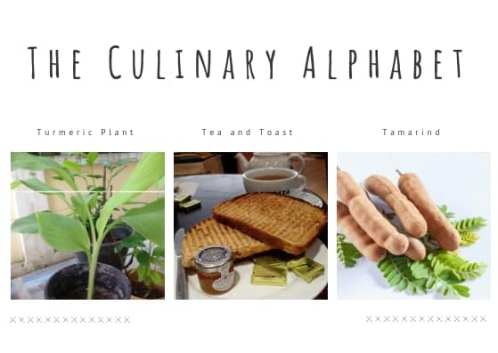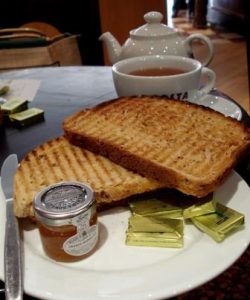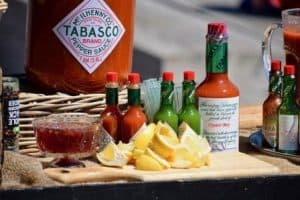
This week some favourites from childhood that is still enjoyed by millions today.. and some more unusual foods and methods beginning with the letter ‘T’.

Tea and Toast
How many times in your life have you been offered tea and toast. Maybe never but it was something which when I was growing up was a telling example of your class and status.
Drinking tea and eating toast revealed more about you than you could ever imagine…For example, the taking of sugar in your tea was seen as a definite habit of the lower classes…even just a tincy winsy tiny bit more than one spoonful and you were definitely in the lower middle class ( at best)…More than two….working class and not only that cemented your status if you added your milk first and stirred noisily…Working-class…
To the English tea also had practically magical properties and that was across all the class lines. Headache or a skinned knee, out came the teapot. Bruised ego, bereavement or divorce, and out came the teapot. It was the balm to soothe most ills.
 Photo credit: trawets1 on VisualHunt / CC BY-NC-SA
Photo credit: trawets1 on VisualHunt / CC BY-NC-SA
Add toast to the equation and we really came into our own, haha
It must be cool and dry, no soggy toast and it was also a matter of class how you ate that toast. I mean if you slathered it with butter and marmalade and god forbid if it wasn’t Dundee marmalade, and then proceed to take a bite. So vulgar it was the height of bad manners. The correct way: Take a small piece and add just a smidgen of marmalade before taking a gentile bite. That guys and gals are how Toast and Tea are taken in England, according to your class of course.
Tabasco Sauce – TABASCO®
Original Red Pepper Sauce is made with three simple ingredients and aged in oak barrels for up to three years on Avery Island, Louisiana, before bottling. The recipe originating from Edmund McIlhenny in 1868 has been used by the McIlhenny family for nearly 150 years, just aged vinegar, salt, and peppers make this versatile hot pepper sauce.

Image by iSAW Company from Pixabay
Are you familiar with the following The Culinary Alphabet T terms?
Tabbouleh
Traditionally served as part of a Meze in the Arab world it has fast grown in popularity in the Western world. I do love how increased travel and the internet have broadened our Culinary World. Tabouli salad or Tabbouleh is a simple Mediterranean salad of very finely chopped vegetables, lots of fresh parsley and bulgur wheat, all tossed with lime juice and olive oil.
Tahini
Tahini is a thick paste-like sauce made from sesame seeds, with a little bit of oil mixed in to make it the right consistency, and usually not much else. Tahini is similar to peanut butter in texture: creamy, oily, and smooth, and like peanut butter is rich in calcium. Tahini is a common ingredient in many vegetarian and vegan recipes (particularly in salad dressings and homemade hummus) and it is often used in Middle Eastern cooking.
How to make your very own Tahini paste/butter, it is so quick and easy and the cost of a packet of sesame seeds is virtually pennies against the cost of a store-bought jar of tahini and no nasties.
- Into the kitchen, just quickly toast the Sesame Seeds,
- then into the mini blender,
- 3 tbsp Olive oil, and a quick whizz,
- scrape down the sides,
- another tbsp Olive oil and another scrape,
- a bit more oil and a quick whizz and voila your Tahini Paste is made.
How easy is that?
Tamarind
One of my favorite cooking ingredients I love tamarind either just eaten as a fruit or used in cooking. Available everywhere here it is very popular and healthy. To learn more about the Tamarind tree and some recipes where Tamarind is used. Click Here

My favorite is the young tamarind pictured here only available for a very short period but a lovely way to eat the tamarind…
Tempura
I prefer the lightness of tempura batter and it is used often in Asian recipes. Specially formulated tempura flour is available in worldwide supermarkets. This is generally light (low-gluten) flour, and occasionally contains leaveners such as baking powder. Tempura is very prevalent in Japanese cookery today most of the major changes to the tempura were In the early 17th century, around the Tokyo Bay area, tempura ingredients and preparation underwent a remarkable change as the Yatai (food cart) culture gained popularity.
Making the best use of fresh seafood while preserving its delicate taste, tempura used only flour, eggs, and water as ingredients and the batter was not flavored. As the batter was mixed minimally in cold water, it avoided the dough-like stickiness caused by the activation of wheat gluten, resulting in the crispy texture which is now characteristic of tempura. It became customary to dip tempura quickly in a sauce mixed with grated daikon just before eating it.
Tapenade
The name for a dish of pureed or finely chopped olives, capers, and olive oil.it is a lovely dip served with beautiful bread or crackers and of course a lovely glass of wine on a lovely summers evening. Quick and simple to make it can also be used as a stuffing for poultry.
Elephants Ears

I had lived here for a while before I realized what these huge leaved plants were in the field near our house and the river that runs alongside had massive ones some of those leaves reached 3 feet long and 2 feet wide and the plants can grow 8 feet tall.
The elephant ears thirst for water is why they are so prolific in soggy areas and they are also popular here not only for landscaping but also near water features they are quite an impressive plant.
The corms or roots are also to be found on every market stall it’s Taro. Silly me!
Tasso
Tasso ham is a specialty of south Louisiana cuisine. In this case, “ham” is a misnomer since tasso is not made from the hind leg of a pig, but rather the pig’s shoulder. This cut is typically fatty, and because the muscle is constantly used by the animal, it has a great deal of flavor.
Temper
As I make all my own Indian curries and spices I temper spices a lot. It is also a term used in many custard and soup recipes when you are required to “temper” an egg which means that you need to raise the temperature of an egg gradually, essentially cooking it without scrambling it. A tempered egg will look basically like raw egg, but will be perfectly cooked, and used as a binding agent or thickener.
Truss
Something I always leave to hubby as he knows his knots…It is however a way to tie a chicken…
Turmeric
I think most of us have heard of Turmeric by now. It is most commonly used in Asian food and comes from the root of the Turmeric plant. Used in curries it has a warm, bitter taste and has many culinary uses apart from just flavoring or coloring curry powders. I use it when I make mustard which is where mustard gets its yellow color from also butter and cheeses. I also use the Turmeric leaf when I make the Indonesian dish of Beef Rendang. The root is widely used around the world to make medicines.
Last but not least one more entry on The Culinary Alphabet T
Tripe
Before we go any further I will tell you that I never have, never will, have no desire to eat tripe. My grandfather and father loved tripe. Tripe is for sale everywhere you look here and eaten and enjoyed by Thais. Tripe is a type of edible lining from the stomachs of various farm animals. Most tripe is from cattle and sheep. National tripe day (yes) it is true celebrated on 24th October. I may be writing about it, I most certainly will not be eating it.
I eat many things, Ant eggs, chicken feet, frogs and insects, crispy fried, No squidgy ones, Never tripe. What are your thoughts on tripe, Do you love it? Or are in my camp of never tried it and never will?
That’s all for The Culinary Alphabet T, I hope it has been both enjoyable and informative and look forward to seeing you next time with the letter ‘U’.

About Carol Taylor
Enjoying life in The Land Of Smiles I am having so much fun researching, finding new, authentic recipes both Thai and International to share with you. New recipes gleaned from those who I have met on my travels or are just passing through and stopped for a while. I hope you enjoy them.
I love shopping at the local markets, finding fresh, natural ingredients, new strange fruits and vegetables ones I have never seen or cooked with. I am generally the only European person and attract much attention and I love to try what I am offered and when I smile and say Aroy or Saab as it is here in the north I am met with much smiling.
Some of my recipes may not be in line with traditional ingredients and methods of cooking but are recipes I know and have become to love and maybe if you dare to try you will too. You will always get more than just a recipe from me as I love to research and find out what other properties the ingredients I use have to improve our health and wellbeing.
Exciting for me hence the title of my blog, Retired No One Told Me! I am having a wonderful ride and don’t want to get off, so if you wish to follow me on my adventures, then welcome! I hope you enjoy the ride also and if it encourages you to take a step into the unknown or untried, you know you want to…….Then, I will be happy!
Carol is a contributor to the Phuket Island Writers Anthology: Amazon US
Connect to Carol- Blog: Carol Cooks 2 – Twitter: @CarolCooksTwo – Facebook: Carol Taylor
My thanks to Carol for sharing this series with us as she also works on her cookbook and novel this year…As always we are delighted to receive your feedback and if you could share that would be great.. thanks Sally.

Very interesting about the tea and toast. I take my tea black with no sugar. As for the toast, I am very uncouth, I’m afraid. Slathered with butter and dripping with jam.
LikeLiked by 2 people
That’s not uncouth Liz.. that is how it is meant to be..dry toast is awful.. and jam needs butter…perfect..xx
LikeLiked by 2 people
Thanks for the affirmation, Sally!
LikeLiked by 1 person
Sounds perfect to me, Liz…I would fail big time on this etiquette malarky 🙂 x
LikeLiked by 2 people
😀
LikeLiked by 2 people
Pingback: Smorgasbord Blog Magazine Weekly Round Up – 11th -17th October 2020 -Jazz, Elephant’s Ears, Pumpkin Flower Fritters and Rennaisance Festival | Smorgasbord Blog Magazine
When I lived in Lancashire I saw tripe on sale in the market but never tried it as I wasn’t sure how to cook it. Then, in Pakistan in a friend’s house I was eating the most delicious curry ever though I had no idea what it was – of course, I later discovered it was tripe. I’ve still never cooked it here, though. The other thing very popular in Lancashire, which I did try as it came ready cooked, was elder, or cow’s udder.
LikeLiked by 2 people
Thanks for sharing that Mary.. glad the curry was delicious but perhaps the cow’s udder might have waited until I had finished my lunch lol..However, I am a great fan of offal and using as much of an animal as possible to show it the greatest respect.. xx
LikeLiked by 2 people
Sorry if I spoiled your lunch, Sally!
LikeLiked by 1 person
Lol.. I will get over it Mary…hugsx
LikeLiked by 1 person
I am sure if cooked correctly it is as you have testified delicious…as for cows udder again nothing I would want to go out of my way to try however every single part of the animal is eaten here and I would never say never based on that premise…I love offal and haggis is traditionally made in a stomach lining so…I rest my case…Don’t we have some interesting conversations here?…:) x
LikeLiked by 2 people
We certainly do….lol.. xx
LikeLiked by 1 person
Don’t we just! 🙂
LikeLiked by 2 people
All great choice of food, Carol. Tahini is the one that doesn’t agree with me. Looking forward to the next one.
LikeLiked by 2 people
Thank you, Valentina…Yes, we are getting towards the end of the alphabet I hope you enjoy the letter U….have a lovely week 🙂
LikeLiked by 2 people
I enjoy food in all the letters, Carol. You have a good rest of the week.😀
LikeLiked by 2 people
You too, Valentina we also love a variety of food 🙂 Its good to eat 🙂
LikeLiked by 2 people
Oh, tell me about it, I enjoy food too much.
LikeLiked by 2 people
Thanks Valentina..hugsx
LikeLike
tea and toast – what a great combo. I think I recall when we were in London a couple of years ago that many places served a tea known as worker’s tea, which had milk and sugar. Now I know why!
And in Singapore, I had teh and kaya toast almost every morning…
LikeLiked by 2 people
Tea makes the world go round… there in good and bad times.. and with a bit of buttered toast, nothing better…xx
LikeLiked by 1 person
or jam… 🙂
LikeLiked by 2 people
True…x
LikeLiked by 1 person
I remember your post on Teh and kaya toast, Jim…Ahhh workers tea and probably served in a big mug…A great institution we British love our traditions 🙂
LikeLiked by 2 people
of course I had to try the workers tea – for research purposes of course… 🙂
LikeLiked by 2 people
Of course…so important a bloggers research one never knows when it will be required …hehe
LikeLiked by 2 people
it came in handy replying to your post!
LikeLiked by 2 people
There you go then… 👀😁
LikeLiked by 2 people
Haha, CArol, your tea and toast class comments made me laugh. My mom always makes me add milk first so that the tea cup doesn’t get stained, but no sugar, not a single crystal.
LikeLiked by 2 people
Good for your mom Robbie…xxx
LikeLiked by 1 person
Pleased I raised a titter or two Robbie…my mum always added the milk first I add the milk last but like you no sugar…Enjoy your week 🙂 x
LikeLiked by 2 people
What great and very interesting things.I enjoy the British behaviour around tea. Here we only have beer. I cannot remember things here that would show the differences in social classes when drinking beer. Except, of course, that people from higher classes do not get drunk haphazardly! Lol Thank you for sharing! Michael
LikeLiked by 2 people
Tea is a British Institution, Michael…Still debated over what makes a good cuppa after all these years…Maybe it is lucky you only have a beer…I certainly would not want to officiate that debate…Have a great week 🙂 xx
LikeLiked by 1 person
lol… thanks for the tip Michael.. Bavarian beer is famous but it is good to know how to distinguish the social classes..hugsx
LikeLiked by 1 person
Lol – You have to eat a lot of pork before drinking this beer. 😉
LikeLiked by 1 person
Not a problem as long as there is crackling..xx
LikeLike
Some great items! Tea and toast is an essential here. You’re right, any emotion from joy to misery is greeted with a cuppa. As for tripe, I’m definitely in the avoid at all costs camp!
LikeLiked by 2 people
Oh.. I know Viv it soon dyes your hands.. I use the leaves when I make Rendang a beautiful Indonesian dish.. I am definitely in the no to tripe camp,Viv…😀 💕
LikeLiked by 2 people
lol seems like William and Carol’s husband are the only takers…just about to have a cup of tea.. would not be a good day without it..xx
LikeLiked by 1 person
They are welcome to it …Hugs xx
LikeLiked by 1 person
A word of warning about turmeric. It is also used as a dye, and it seems to dye everything. (Even my frying pan!) I recently watched a programme about a village in India where they grow it. They seem to use it for everything.
I love tapenade, but am with you on tripe. I did try it once, as a child, when my dad, who loved it (tripe and onions), was eating it. (Everyone else was eating something sensible.) i’ve never tried it since!
LikeLiked by 2 people
Turmeric is an all rounder… I use gloves when dealing with oil infused turmeric as that is really hard to shift but great in soups and stews.. xxx
LikeLiked by 1 person
There are quite a few foods that I fancy in your ‘T’ post today, Carol, and among them is tripe. My great grandmother made tripe when I was a child and my father and I were the only ones in the family who ate them aside from her and my great granddaddy, so I got off to an early start. I remember no one entered the house while she was cooking them because of the smell. Here in France now, in 4 star restaurants, you can find tripe on the menu and they are as good as what I remember as a child. How about that? Loved your post, as always. Hugs
LikeLiked by 2 people
Thanks William…you do know that you seem to be in the minority!…perhaps we all need to head over (quarantine permitting) and you can take us to lunch and prove us wrong….hugsxx
LikeLiked by 1 person
Ahhhh, Will, I am pleased you enjoy your tripe(my hubby) does…I will however and I try a variety of different foods but never could be persuaded to try tripe…It wouldn’t however be good for us all to be alike but as Sally said lunch could prove us wrong…Hugs xx
LikeLiked by 1 person
lol.. poor William… looks like a party..xx
LikeLiked by 1 person
Haha… He would love it… 💕
LikeLiked by 1 person
I certainly would. Cheers and hugs.
LikeLiked by 2 people
Carol – your writing has such a nice flow!
This post was packed with some awesome info and did not realize making tahini could be so easy!
Also – saw a documentary and it mentioned why the lower economic class added milk first before their tea? Of course you do – but I didn’t and they said the lower economic class had cheaper pottery and the hot tea could make the cups crack – so adding the milk cooled it a bit –
LikeLiked by 2 people
Thank you for your kind words…I just love to write…I never saw that docu ..Ahhh that’s why my bone china didn’t crack then…We are pleased you enjoyed the post be well and stay safe 🙂 x
LikeLiked by 1 person
Glad you enjoyed… milk goes in after in my husband’s family and first in mine… opposites attract…
LikeLike
What a tempting collection of T words. Thank you, Sally and Carol. Toni x
LikeLiked by 2 people
You are most welcome, Toni…we are pleased you enjoyed the collection of foods 🙂 xx
LikeLiked by 2 people
Thanks Toni.. don’t eat them all at once lol..xx
LikeLike
Carol, you live in a land where exotic foods like Tamarind exist. And possibly Tahini. The “T” word that stood for me was Turmeric. My son gave me a plant for Mother’s Day, and he showed me how to harvest the goodness from the root. I even blogged about it: https://marianbeaman.com/2020/07/15/fresh/
I agree with you about the balm of tea – and you are getting closer to “Z”!
LikeLiked by 2 people
I am indeed, Marian my how time flies…Tahini is in Hummus which I believe is available worldwide…Enjoy your Tumeric plant you can also use the leaves in recipes as an aromatic…or use them to wrap and cook fish or deserts a very versatile plant 🙂 x
LikeLiked by 1 person
Leaves to wrap fish – I must try that!
LikeLiked by 1 person
The best way to cook fish.. Enjoy!
LikeLiked by 1 person
Thanks Marian and enjoy your Turmeric plant.. a spice that is a staple in our household..xx
LikeLike
Reblogged this on Retired? No one told me! and commented:
The letter T….so many wonderful foods beginning T…and Elephants Ears which are a T…you will have to read on to find out why or do you know already ?
LikeLiked by 1 person
Love the T foods today! Tahini, Tamarind and Tempura, yum! And with Carol on yuck to tripe! ❤
LikeLiked by 3 people
So many wonderful foods beginning T…with the one exception(Tripe) welcome to my camp, Debs xxx
LikeLiked by 2 people
LOL, definitely in your camp! ❤
LikeLiked by 2 people
Yes tripe is not on my shopping list although David has enjoyed in the past – pre-marriage.. not since lol…xx♥
LikeLiked by 2 people
Whew! Glad you got him out of that habit. LOL ❤
LikeLiked by 1 person
me too…♥
LikeLiked by 1 person
❤
LikeLike
Reblogged this on Plaisted Publishing House.
LikeLiked by 2 people
Thank you so much Patty for the reblog…I hope you are well xxx
LikeLiked by 2 people
You are very welcome. And yes, I am doing well.
LikeLiked by 1 person
Good to hear Patty. X
LikeLiked by 1 person